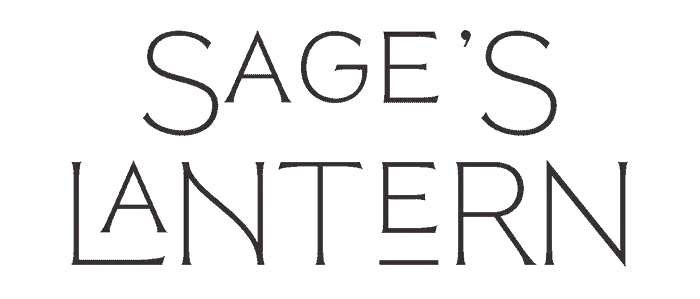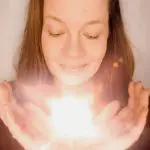You might have heard of court cards in the tarot deck, but you are unsure what they are and what they look like. It is common for seasoned tarot readers to forget that not everyone knows what court cards are. But do not worry; I’ve got you covered!
Tarot court cards include the page, Knight, queen, and king. They derive from royal hierarchy and represent persons, personality traits, and roles in tarot readings. They are included in the Minor Arcana suits, pentacles, swords, wands, and cups.
The Court Cards provide insights into roles and behavioral patterns, representing different facets of our personality and the people in our lives. In this article, you learn what the cards look like and what they mean in a tarot reading.
If you want a cheat sheet of all the meanings of the tarot cards, click the link below.
Related reading: Tarot cheat sheet
What court cards are
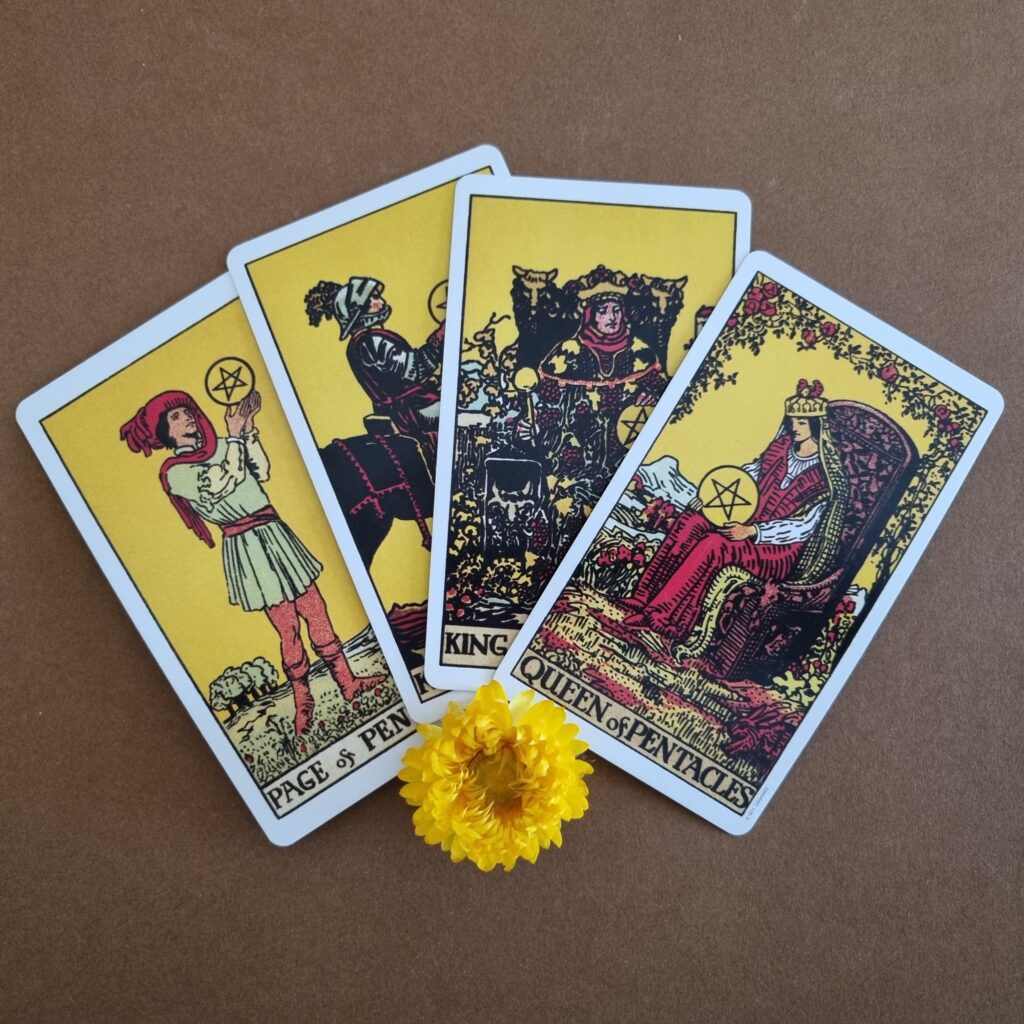
The Tarot deck has evolved over centuries, with its origins speculated to trace back to ancient Egypt or medieval Europe.
The court cards, mainly influenced by the playing cards used in the Middle Ages, symbolized ranks in a hierarchical society.
Over time, these cards have been adapted and infused with symbolic meanings, offering profound insights into the human experience.
Over time, these cards have been adapted and infused with symbolic meanings, offering profound insights into the human experience.
Sandra Törnroth
Nowadays, the essence of the hierarchy is still there, but with added modern influences to fit the contemporary world.
They can refer to people surrounding us or ourselves. Because of this diversification, many think court cards are the trickiest to decipher in readings. But don’t stress; by the end of this article, you will know how to read court cards like a pro.
What court cards look like
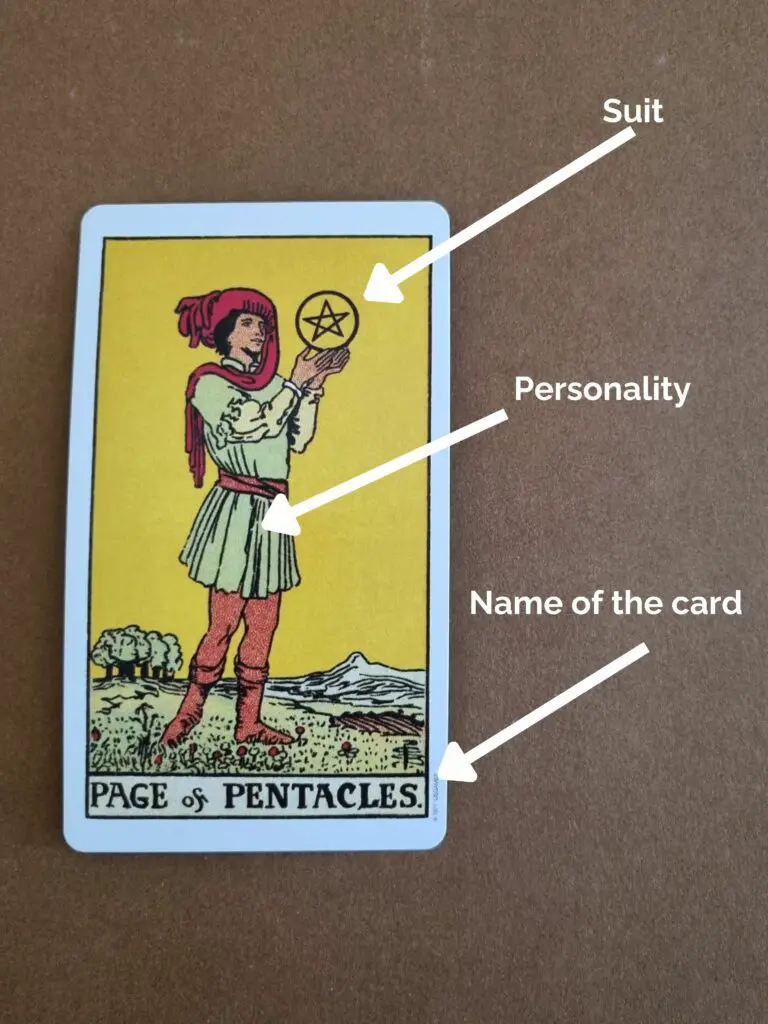
The Tarot’s court cards are part of the Minor Arcana, divided into four suits: Cups, Pentacles (or Coins), Swords, and Wands (or Rods).
Each suit has its own set of court cards, which typically include the Page, Knight, Queen, and King.
I recommend reading the article below if you are unfamiliar with the suits and what they represent. This will make it easier for you to understand the different dimensions of court cards.
Further reading: What Tarot Suits Are: A Total Beginner’s Guide
General description of tarot court cards
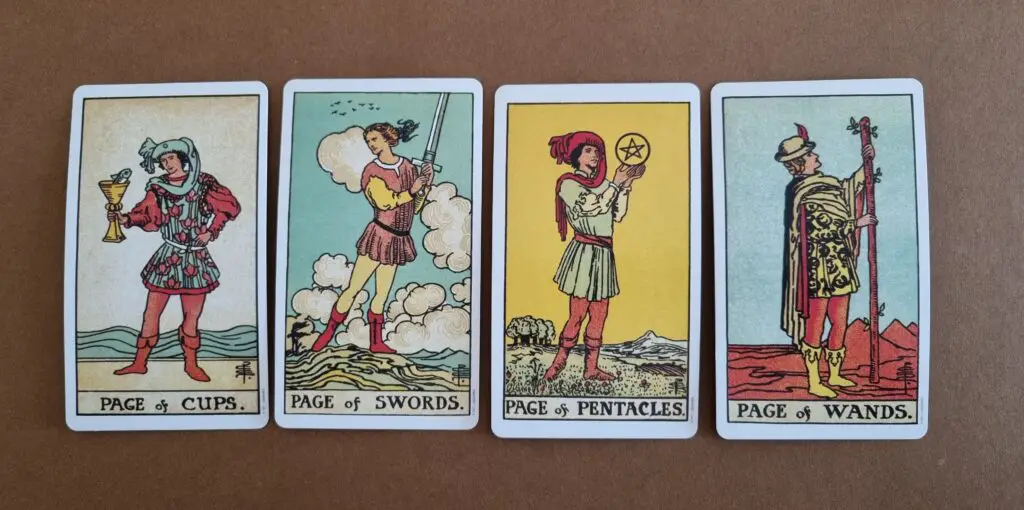
Page
- General Appearance: Typically depicted as a young person or a figure representing youthfulness, curiosity, and, at times, naivety.
- Cups: Holding a cup, often surrounded by water or a scene, suggests emotions and intuition.
- Pentacles: Holding a pentacle or coin, sometimes surrounded by scenes indicating material aspects, nature, or physical well-being.
- Swords: Holding a sword, often with clouds representing the mood and signifying mental activity or conflicts.
- Wands: Holding a wand, typically against a desert or budding forest backdrop, suggests inspiration or creativity.
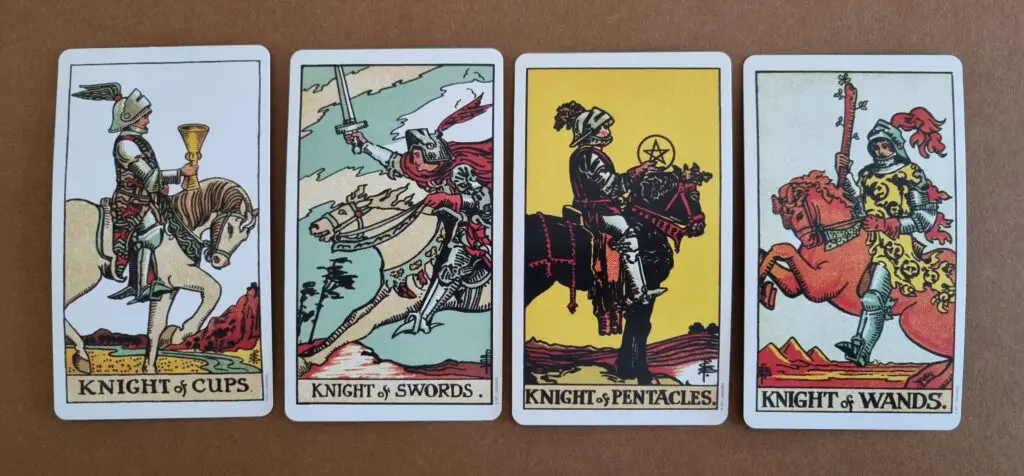
Knight
- General Appearance: Usually shown as a young adult, often riding a horse, representing movement and action.
- Cups: Riding across or near water, holding a cup, indicating following one’s heart or emotional pursuits.
- Pentacles: Riding through a fertile landscape, holding a pentacle, denoting pursuing material goals or practical ventures.
- Swords: Riding into or through a stormy sky, sword raised, suggesting challenges or intellectual pursuits.
- Wands: Riding across a desert or dynamic terrain, holding a wand, representing a quest for passion or creative endeavors.
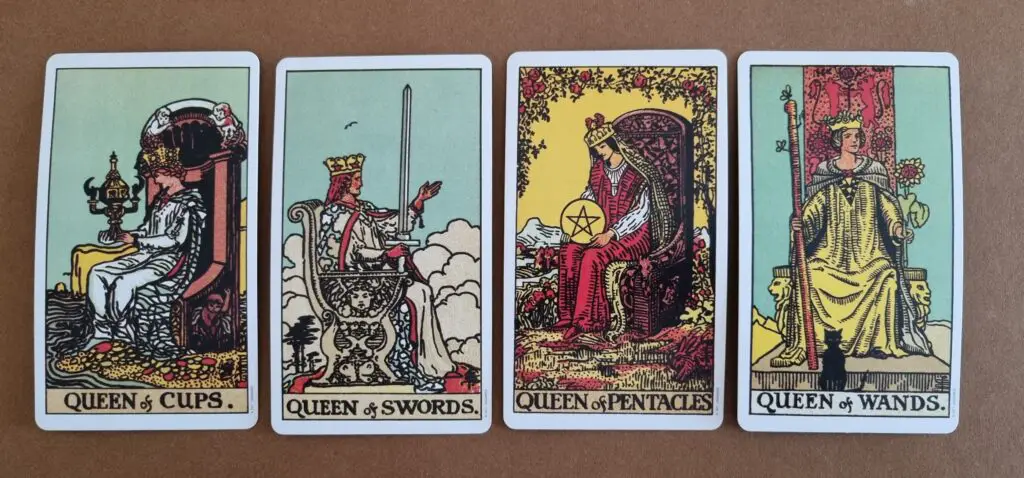
Queen
- General Appearance: A mature woman, often seated on a throne, symbolizing mastery and introspection.
- Cups: Holding a cup surrounded by water or a serene environment represents emotional depth and intuition.
- Pentacles: Holding a pentacle, surrounded by a lush or abundant scene, denoting material security and nurturing qualities.
- Swords: Holding a sword, usually with a clear or cloudy sky, representing clear thinking or intellectual authority.
- Wands: Holding a wand amidst a desert or thriving forest signifies creative mastery and inspirational leadership.
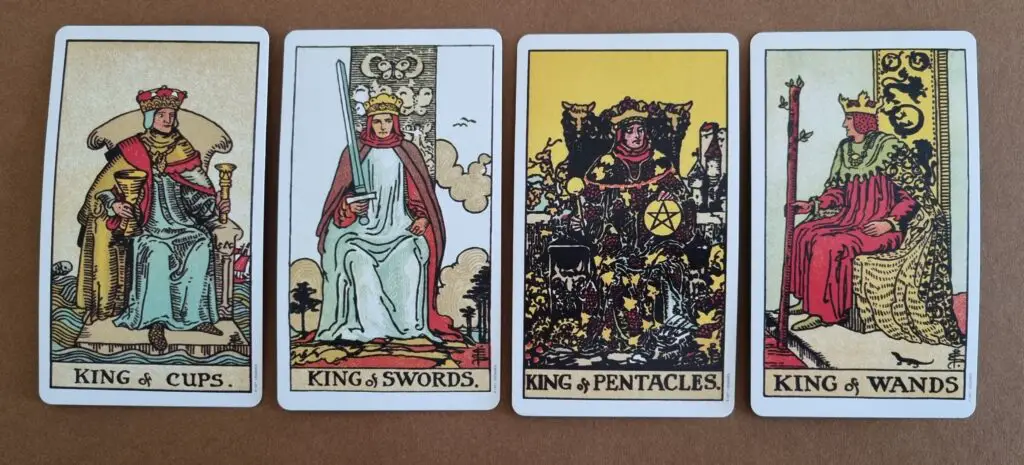
King
- General Appearance: A mature man seated on a throne, embodying authority and control.
- Cups: Holding a cup in a calm or watery setting, symbolizing emotional stability and compassion.
- Pentacles: Holding a pentacle in a scene of abundance or a castle, indicating material success and leadership.
- Swords: Holding a sword, usually with a mix of clear and stormy skies, denoting intellectual power and decision-making.
- Wands: Holding a wand in a dynamic or evolving landscape, representing creative authority and visionary leadership.
It’s important to note that these descriptions are based on traditional Tarot imagery, particularly from decks like the Rider-Waite-Smith. There are numerous Tarot decks available, each with its unique artistic interpretation of the court cards.
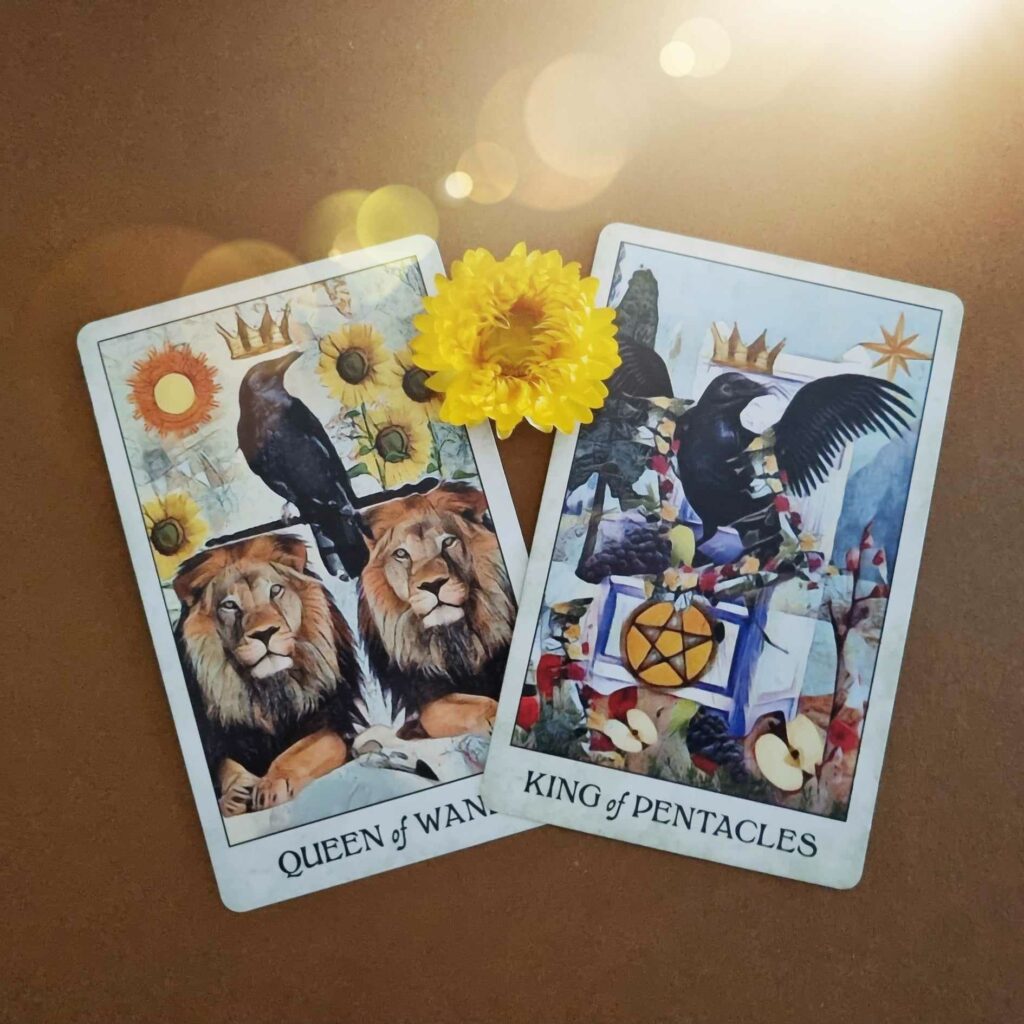
Some modern decks might incorporate more inclusive or diverse representations, change gender roles, or adjust the imagery to match specific themes or cultural contexts.
The Royal Hierarchy
If you are not familiar with the royal hierarchy, it is pretty simple. In short, pages are the young energy. Pages were attendants that served the court or nobleman. Think of a teen or young adult at the beginning of their career.
The Knight is often connected with adult energy. When the page was fully trained, he became a knight. The Knight was a soldier with rank. They got their title from the kingdom or church. Think of an adult person gaining social status through work and commitments.
The queen is connected with feminine energy. This does not mean the queen needs to be female; it is the energy we refer to. The queen is the silent ruler beside the king. I see this as a quiet power, maybe a diplomat-. Many see the queen as the “wife” with her secret influence over the public s
The king is connected with male energy. The king is the ruler of the kingdom and gives directions and orders. The energy is authoritative and affirmative.
It is important to remember that queens and kings do not have to be female or male; it is the energy it refers to.
What the page represents
The Pages, as the youngest members of the court, often signify messages, new beginnings, or potential yet to be realized. Depending on their suit—Cups, Pentacles, Swords, or Wands—they can represent emotional, material, mental, or creative initiations, respectively.
What the Knight represents
Knights are all about movement, action, and pursuit. Representing the fiery phase of youth and young adulthood, each Knight, depending on their suit, can depict the energetic chase of emotions, wealth, ideas, or passions.
WHAT THE QUEEN REPRESENTS
The Queens, as maternal and introspective figures, resonate with the deeper, intuitive side of us. They invite us to look inward, trust our instincts, and embrace the power of emotions, material security, thoughts, or inspiration—once again, contingent on their respective suit.
wHAT THE KING REPRESENTS
Kings signify the culmination of the court’s journey. They’ve mastered their domain and showcase leadership, control, and authority. In readings, they can indicate mastery over one’s emotions, finances, thoughts, or ambitions.
Common misconceptions regarding court cards
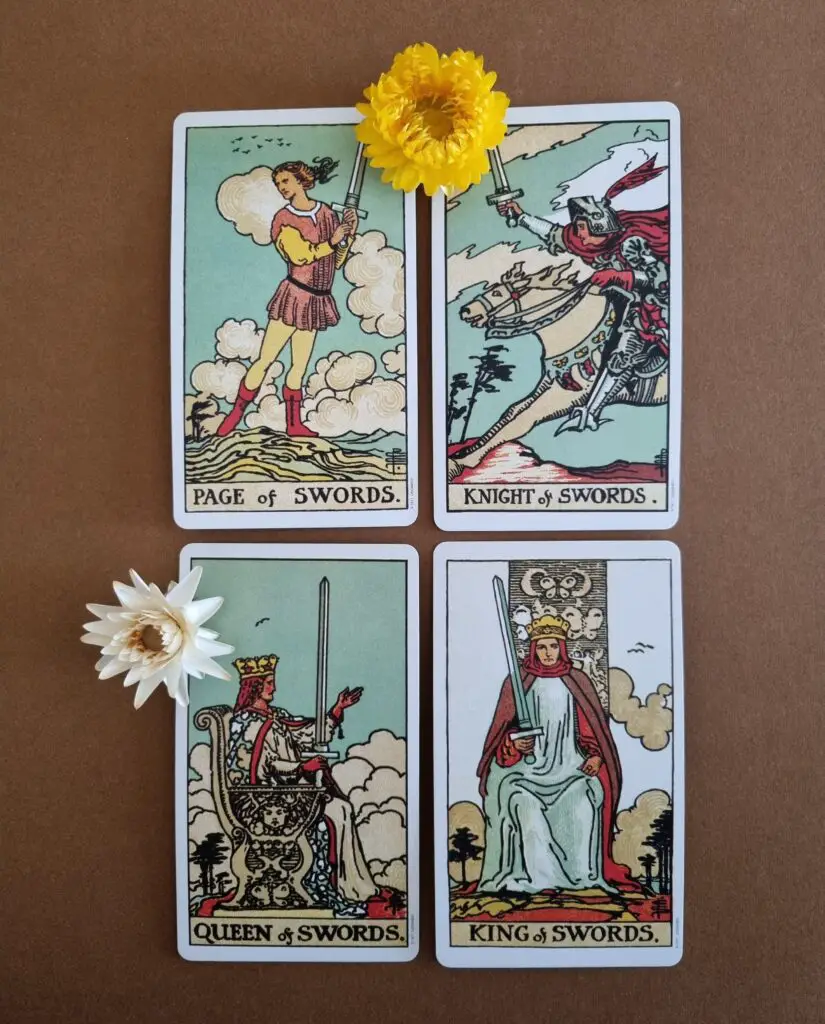
One major misconception is that court cards solely represent real people. While they can, they’re equally potent as symbols for phases of life or personal attributes.
Another myth is that their gender strictly denotes male or female energies. In truth, they encompass a spectrum of energies, transcending societal gender norms.
Court cards in tarot spreads
Court cards are sometimes tricky to understand. With practice, it becomes easier. These are my best tips when a court card appears in your spread.
- Consider the context: Look at surrounding cards for clues.
- Intuitively connect: Sometimes, a card’s traditional meaning might not resonate. Trust your intuition.
- Practice makes perfect: The more you work with court cards, the more you’ll intuit their nuanced messages.
The meaning of tarot cards can differ depending on whether they are upright or reversed. If you want to learn more about this, I invite you to read the article below.
Further reading: Reversed Tarot Cards: What They Are And How To Read Them
Final thoughts
Court cards can be tricky. Their meanings can shift based on their position in a spread, the question asked, or the cards around them. They might represent people in your life, aspects of yourself, or situations that embody their characteristics.
Their position within a spread can reveal how a particular energy or person influences your life. For instance, a Queen in a past position might indicate a nurturing influence that has shaped your current situation.
The court cards add a layer of richness to tarot readings. Whether they’re reflecting our deepest selves or the people around us, understanding their significance is crucial in unlocking the full potential of the Tarot.
If you find court cards a struggle, I’m always here to help you read your cards. You can learn more about my services here.
